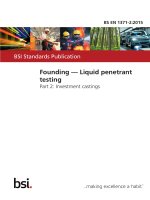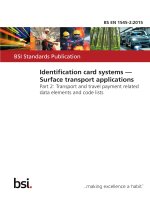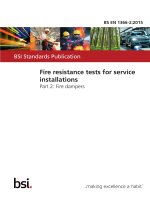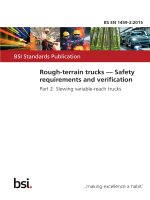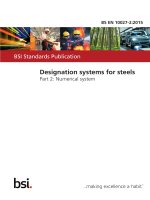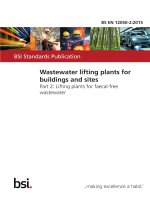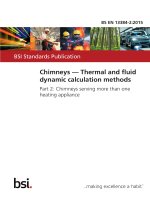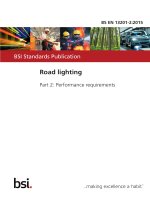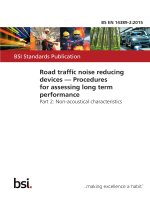Bsi bs en 61010 2 040 2015
Bạn đang xem bản rút gọn của tài liệu. Xem và tải ngay bản đầy đủ của tài liệu tại đây (1.37 MB, 44 trang )
BS EN 61010-2-040:2015
BSI Standards Publication
Safety requirements for
electrical equipment for
measurement, control,
and laboratory use
Part 2-040: Particular requirements for
sterilizers and washer-disinfectors used
to treat medical materials
BRITISH STANDARD
BS EN 61010-2-040:2015
National foreword
This British Standard is the UK implementation of EN 61010-2-040:2015.
It is identical to IEC 61010-2-040:2015. It supersedes BS EN 61010-2-040:2005,
which will be withdrawn on 11 August 2018.
The UK participation in its preparation was entrusted to Technical
Committee EPL/66, Safety of measuring, control and laboratory
equipment.
A list of organizations represented on this committee can be obtained on
request to its secretary.
This publication does not purport to include all the necessary provisions of a
contract. Users are responsible for its correct application.
© The British Standards Institution 2015.
Published by BSI Standards Limited 2015
ISBN 978 0 580 78856 7
ICS 11.080.10; 19.080; 71.040.10
Compliance with a British Standard cannot confer immunity from
legal obligations.
This British Standard was published under the authority of the
Standards Policy and Strategy Committee on 30 September 2015.
Amendments/corrigenda issued since publication
Date
Text affected
BS EN 61010-2-040:2015
EUROPEAN STANDARD
EN 61010-2-040
NORME EUROPÉENNE
EUROPÄISCHE NORM
September 2015
ICS 19.080; 71.040.10
Supersedes EN 61010-2-040:2005
English Version
Safety requirements for electrical equipment for measurement,
control, and laboratory use - Part 2-040 Particular requirements
for sterilizers and washer-disinfectors used to treat medical
materials
(IEC 61010-2-040:2015)
Règles de sécurité pour appareils électriques de mesurage,
de régulation et de laboratoire - Partie 2-040: Exigences
particulières pour stérilisateurs et laveurs désinfecteurs
utilisés pour traiter le matériel médical
(IEC 61010-2-040:2015)
Sicherheitsbestimmungen für elektrische Mess-, Steuer-,
Regel- und Laborgeräte - Teil 2-040: Besondere
Anforderungen an Sterilisatoren und ReinigungsDesinfektionsgeräte für die Behandlung medizinischen
Materials
(IEC 61010-2-040:2015)
This European Standard was approved by CENELEC on 2015-08-11. CENELEC members are bound to comply with the CEN/CENELEC
Internal Regulations which stipulate the conditions for giving this European Standard the status of a national standard without any alteration.
Up-to-date lists and bibliographical references concerning such national standards may be obtained on application to the CEN-CENELEC
Management Centre or to any CENELEC member.
This European Standard exists in three official versions (English, French, German). A version in any other language made by translation
under the responsibility of a CENELEC member into its own language and notified to the CEN-CENELEC Management Centre has the
same status as the official versions.
CENELEC members are the national electrotechnical committees of Austria, Belgium, Bulgaria, Croatia, Cyprus, the Czech Republic,
Denmark, Estonia, Finland, Former Yugoslav Republic of Macedonia, France, Germany, Greece, Hungary, Iceland, Ireland, Italy, Latvia,
Lithuania, Luxembourg, Malta, the Netherlands, Norway, Poland, Portugal, Romania, Slovakia, Slovenia, Spain, Sweden, Switzerland,
Turkey and the United Kingdom.
European Committee for Electrotechnical Standardization
Comité Européen de Normalisation Electrotechnique
Europäisches Komitee für Elektrotechnische Normung
CEN-CENELEC Management Centre: Avenue Marnix 17, B-1000 Brussels
© 2015 CENELEC All rights of exploitation in any form and by any means reserved worldwide for CENELEC Members.
Ref. No. EN 61010-2-040:2015 E
BS EN 61010-2-040:2015
EN 61010-2-040:2015
European foreword
The text of document 66/570/FDIS, future edition 2 of IEC 61010-2-040, prepared by IEC/TC 66
"Safety of measuring, control and laboratory equipment" was submitted to the IEC-CENELEC parallel
vote and approved by CENELEC as EN 61010-2-040:2015.
The following dates are fixed:
•
latest date by which the document has to be implemented at
national level by publication of an identical national
standard or by endorsement
(dop)
2016-05-11
•
latest date by which the national standards conflicting with
the document have to be withdrawn
(dow)
2018-08-11
This document supersedes EN 61010-2-040:2005.
Attention is drawn to the possibility that some of the elements of this document may be the subject of
patent rights. CENELEC [and/or CEN] shall not be held responsible for identifying any or all such
patent rights.
Endorsement notice
The text of the International Standard IEC 61010-2-040:2015 was approved by CENELEC as a
European Standard without any modification.
In the official version, for Bibliography, the following notes have to be added for the standards indicated:
2
IEC 60079
NOTE
Harmonized in EN 60079 series.
IEC 60335-2-4
NOTE
Harmonized as EN 60335-2-4.
IEC 60335-2-5
NOTE
Harmonized as EN 60335-2-5.
IEC 60335-2-7
NOTE
Harmonized as EN 60335-2-7.
IEC 60335-2-11
NOTE
Harmonized as EN 60335-2-11.
IEC 60335-2-58
NOTE
Harmonized as EN 60335-2-58.
IEC 60601-1
NOTE
Harmonized as EN 60601-1.
IEC 60825-1
NOTE
Harmonized as EN 60825-1.
IEC 61010-2-010
NOTE
Harmonized as EN 61010-2-010.
IEC 61058
NOTE
Harmonized in EN 61058 series.
IEC 61672-1
NOTE
Harmonized as EN 61672-1.
BS EN 61010-2-040:2015
EN 61010-2-040:2015
IEC 61672-2
NOTE
Harmonized as EN 61672-2.
IEC 62061
NOTE
Harmonized as EN 62061.
IEC 62304
NOTE
Harmonized as EN 62304.
ISO 10472
NOTE
Harmonized in EN ISO 10472 series.
ISO 12100:2010
NOTE
Harmonized as EN ISO 12100:2010.
ISO 13849-2
NOTE
Harmonized as EN ISO 13849-2.
ISO 14971
NOTE
Harmonized as EN ISO 14971.
3
BS EN 61010-2-040:2015
EN 61010-2-040:2015
Annex ZA
(normative)
Normative references to international publications
with their corresponding European publications
The following documents, in whole or in part, are normatively referenced in this document and are
indispensable for its application. For dated references, only the edition cited applies. For undated
references, the latest edition of the referenced document (including any amendments) applies.
NOTE 1
When an International Publication has been modified by common modifications, indicated by (mod),
the relevant EN/HD applies.
NOTE 2
Up-to-date information on the latest versions of the European Standards listed in this annex is
available here: www.cenelec.eu.
Publication
Year
Title
EN/HD
Year
Addition to Annex ZA of EN 61010-1:2010:
IEC 61770
-
Electric appliances connected to the water
mains - Avoidance of backsiphonage and
failure of hose-sets
EN 61770
-
IEC 62471
-
Photobiological safety of lamps and lamp
systems
EN 62471
-
IEC/TR 62471-2
-
Photobiological safety of lamps and lamp
systems Part 2: Guidance on manufacturing
requirements relating to non-laser optical
radiation safety
-
-
ISO 3585
-
Borosilicate glass 3.3 - Properties
-
-
ISO 4126-1
-
Safety devices for protection against
excessive pressure Part 1: Safety valves
EN ISO 4126-1
-
ISO 4126-2
-
Safety devices for protection against
excessive pressure Part 2: Bursting disc safety devices
EN ISO 4126-2
-
4
–2–
BS EN 61010-2-040:2015
IEC 61010-2-040:2015 © IEC 2015
CONTENTS
FOREWORD ........................................................................................................................... 3
1
Scope and object ............................................................................................................. 5
2
Normative references ...................................................................................................... 6
3
Terms and definitions ...................................................................................................... 6
4
Tests ............................................................................................................................... 7
5
Marking and documentation ............................................................................................. 9
6
Protection against electric shock ................................................................................... 14
7
Protection against mechanical HAZARDS and against HAZARDS related to
mechanical functions ..................................................................................................... 14
8
Mechanical resistance to shock and impact ................................................................... 19
9
Protection against the spread of fire .............................................................................. 19
10
Equipment temperature limits and resistance to heat ..................................................... 19
11
Protection against HAZARDS from fluids .......................................................................... 20
12
Protection against radiation, including laser sources, and against sonic and
ultrasonic pressure ........................................................................................................ 23
13
Protection against liberated gases, substances, explosion and implosion ...................... 25
14
Components .................................................................................................................. 31
15
Protection by interlocks ................................................................................................. 32
16
H AZARDS resulting from application ................................................................................ 32
17
R ISK assessment ........................................................................................................... 32
Annexes ............................................................................................................................... 33
Annex G (informative) Leakage and rupture from fluids under pressure ............................... 33
Annex L (informative) Index of defined terms ....................................................................... 34
Bibliography .......................................................................................................................... 35
Table 101 – Lamp or lamp systems considered photobiologically safe .................................. 24
Table 102 – Lamp or lamp systems considered photobiologically safe under certain
conditions ............................................................................................................................. 24
BS EN 61010-2-040:2015
IEC 61010-2-040:2015 © IEC 2015
–3–
INTERNATIONAL ELECTROTECHNICAL COMMISSION
____________
SAFETY REQUIREMENTS FOR ELECTRICAL EQUIPMENT FOR
MEASUREMENT, CONTROL, AND LABORATORY USE –
Part 2-040: Particular requirements for sterilizers and
washer-disinfectors used to treat medical materials
FOREWORD
1) The International Electrotechnical Commission (IEC) is a worldwide organization for standardization comprising
all national electrotechnical committees (IEC National Committees). The object of IEC is to promote
international co-operation on all questions concerning standardization in the electrical and electronic fields. To
this end and in addition to other activities, IEC publishes International Standards, Technical Specifications,
Technical Reports, Publicly Available Specifications (PAS) and Guides (hereafter referred to as “IEC
Publication(s)”). Their preparation is entrusted to technical committees; any IEC National Committee interested
in the subject dealt with may participate in this preparatory work. International, governmental and nongovernmental organizations liaising with the IEC also participate in this preparation. IEC collaborates closely
with the International Organization for Standardization (ISO) in accordance with conditions determined by
agreement between the two organizations.
2) The formal decisions or agreements of IEC on technical matters express, as nearly as possible, an international
consensus of opinion on the relevant subjects since each technical committee has representation from all
interested IEC National Committees.
3) IEC Publications have the form of recommendations for international use and are accepted by IEC National
Committees in that sense. While all reasonable efforts are made to ensure that the technical content of IEC
Publications is accurate, IEC cannot be held responsible for the way in which they are used or for any
misinterpretation by any end user.
4) In order to promote international uniformity, IEC National Committees undertake to apply IEC Publications
transparently to the maximum extent possible in their national and regional publications. Any divergence
between any IEC Publication and the corresponding national or regional publication shall be clearly indicated in
the latter.
5) IEC itself does not provide any attestation of conformity. Independent certification bodies provide conformity
assessment services and, in some areas, access to IEC marks of conformity. IEC is not responsible for any
services carried out by independent certification bodies.
6) All users should ensure that they have the latest edition of this publication.
7) No liability shall attach to IEC or its directors, employees, servants or agents including individual experts and
members of its technical committees and IEC National Committees for any personal injury, property damage or
other damage of any nature whatsoever, whether direct or indirect, or for costs (including legal fees) and
expenses arising out of the publication, use of, or reliance upon, this IEC Publication or any other IEC
Publications.
8) Attention is drawn to the Normative references cited in this publication. Use of the referenced publications is
indispensable for the correct application of this publication.
9) Attention is drawn to the possibility that some of the elements of this IEC Publication may be the subject of
patent rights. IEC shall not be held responsible for identifying any or all such patent rights.
International Standard IEC 61010-2-040 has been prepared by IEC technical committee 66:
Safety of measuring, control and laboratory equipment.
It has the status of a group safety publication, as specified in IEC Guide 104.
This second edition cancels and replaces the first edition published in 2005. This edition
constitutes a technical revision.
This edition includes the following significant technical changes with respect to the previous
edition:
a) A new clause (4.3.2.101) has been added for non-electrical supplies and services.
b) Additional requirements for marking and documentation (Clause 5) have been added.
–4–
BS EN 61010-2-040:2015
IEC 61010-2-040:2015 © IEC 2015
c) Additional requirements for protection against mechanical hazards (Clause 7) have been
included.
d) Additional requirements for protection against radiation, including laser sources, and
against sonic and ultrasonic pressure (Clause 12) have been included.
The text of this standard is based on the following documents:
FDIS
Report on voting
66/570/FDIS
66/576/RVD
Full information on the voting for the approval of this standard can be found in the report on
voting indicated in the above table.
This publication has been drafted in accordance with the ISO/IEC Directives, Part 2.
A list of all parts in the IEC 61010 series, published under the general title Safety
requirements for electrical equipment for measurement, control, and laboratory use, can be
found on the IEC website.
This Part 2-040 is intended to be used in conjunction with IEC 61010-1. It was established on
the basis of the third edition (2010). Consideration may be given to future editions of, or
amendments to, IEC 61010-1.
Where a particular subclause of Part 1 is not mentioned in this Part 2-040, that subclause
applies as far as is reasonable. Where this part states “addition”, “modification”,
“replacement”, or “deletion”, the relevant requirement, test specification or note in Part 1
should be adapted accordingly.
In this standard:
1) the following print types are used:
–
requirements: in roman type;
–
NOTES: in small roman type ;
–
conformity and tests: in italic type;
–
terms used throughout this standard which have been defined in Clause 3: SMALL
ROMAN CAPITALS .
2) subclauses, figures, and tables which are additional to those in Part 1 are numbered
starting from 101; additional annexes are lettered starting from AA and additional list
items are lettered from aa).
The committee has decided that the contents of this publication will remain unchanged until
the stability date indicated on the IEC website under "" in the data
related to the specific publication. At this date, the publication will be
•
•
•
•
reconfirmed,
withdrawn,
replaced by a revised edition, or
amended.
BS EN 61010-2-040:2015
IEC 61010-2-040:2015 © IEC 2015
–5–
SAFETY REQUIREMENTS FOR ELECTRICAL EQUIPMENT FOR
MEASUREMENT, CONTROL, AND LABORATORY USE –
Part 2-040: Particular requirements for sterilizers and
washer-disinfectors used to treat medical materials
1
Scope and object
This clause of Part 1 is applicable except as follows:
1.1.1
Equipment included in scope
Replacement:
Replace the existing text with the following:
This part of IEC 61010 specifies safety requirements for electrical equipment intended for
sterilization, washing, and disinfection of medical materials in the medical, veterinary,
pharmaceutical and laboratory fields, when used under the environmental conditions of 1.4.
Examples of such equipment include the following:
a)
sterilizers and disinfectors using steam, and/or hot water as the sterilant;
b)
sterilizers and disinfectors using toxic gas, toxic aerosol or toxic vapour as the sterilant;
c)
sterilizers and disinfectors using hot air or hot inert gas as the sterilant; and
d)
washer disinfectors.
1.1.2
Equipment excluded from scope
Addition:
Add the following note to item f):
NOTE
IEC 60601-1 defines medical electrical equipment as follows:
Electrical equipment, provided with not more than one connection to a particular supply MAINS and intended by its
manufacturer to be used in the diagnosis, treatment, or monitoring of a patient; and that makes physical or
electrical contact with the patient or transfers energy to or from the patient or detects such energy transfer to or
from the patient.
Addition:
Add the following new second paragraph:
This part of IEC 61010 does not apply to the following types of equipment:
aa)
bb)
cc)
dd)
equipment for use in hazardous atmospheres (see IEC 60079) but does apply to an
atmosphere created inside equipment by a flammable sterilizing agent (see 13.0);
laboratory equipment for the heating of materials for other purposes than sterilization or
disinfection (see IEC 61010-2-010);
laundry equipment (see IEC 60335-2-4, IEC 60335-2-7, IEC 60335-2-11, and
ISO 10472), unless designed for disinfecting medical materials;
dishwashers (see IEC 60335-2-5 and IEC 60335-2-58).
–6–
1.2.1
BS EN 61010-2-040:2015
IEC 61010-2-040:2015 © IEC 2015
Aspects included in scope
Replacement:
Replace item g) with the following new text:
g) liberated gases (including the non-intentional escape
substances, explosion and implosion (see Clause 13).
1.2.2
of
toxic
gas),
pathogenic
Aspects excluded from scope
Addition:
Add the following two new items:
aa)
special requirements for protection against chemical and high-risk micro-biological
HAZARDS associated with the LOAD ;
general requirements for the design of calorifiers, shell boilers and PRESSURE VESSELS .
bb)
NOTE National and other regulations or codes apply for the safety of calorifiers, shell boilers and
PRESSURE VESSELS (see 14.101).
2
Normative references
This clause of Part 1 is applicable except as follows:
Addition:
Add the following new references:
IEC 61770, Electric appliances connected to the water mains — Avoidance of back-siphonage
and failure of hose-sets
IEC 62471, Photobiological safety of lamps and lamp systems
IEC TR 62471-2, Photobiological safety of lamps and lamp systems – Part 2: Guidance on
manufacturing requirements relating to non-laser optical radiation safety
ISO 3585, Borosilicate glass 3.3 — Properties
ISO 4126-1, Safety devices for protection against excessive pressure — Part 1: Safety valves
ISO 4126-2, Safety devices for protection against excessive pressure – Part 2: Bursting disc
safety devices
3
Terms and definitions
This clause of Part 1 is applicable except as follows:
3.5.2
HAZARD
Addition:
Add the following new note:
BS EN 61010-2-040:2015
IEC 61010-2-040:2015 © IEC 2015
–7–
Note 1 to entry: In the context of this standard, the term HAZARD relates only to potential sources of
harm to the OPERATOR and surroundings (see 1.2.1), and does not include potential sources of harm
related to the efficacy of the process.
3.5.11
OPERATOR
Addition:
Add the following note:
Note 1 to entry: An OPERATOR includes persons installing, operating, adjusting, maintaining, cleaning, repairing or
moving equipment.
Addition:
Add the following new terms and definitions:
3.2.101
CHAMBER
part of the equipment which receives the LOAD
3.2.102
LOAD
equipment or materials put into a CHAMBER to be processed through an OPERATING CYCLE
3.2.103
STERILIZER
equipment designed to achieve sterilization which comprises a series of actions or operations
needed to achieve the specified requirements for sterility
3.2.104
PRESSURE VESSEL
assembly comprising the CHAMBER , the jacket (if fitted), doors, and all other components in
permanent open connection with the CHAMBER
Note 1 to entry: The PRESSURE VESSEL does not include parts from which it can be isolated, such as steam generators, pipework, and fittings.
3.2.105
OPERATING CYCLE
complete set of stages of the process that is carried out, in a specified sequence
Note 1 to entry:
Loading and unloading are not part of the OPERATING CYCLE .
3.2.106
WASHER - DISINFECTOR
equipment intended to clean and disinfect medical devices and other articles used in the
context for example of medical, dental, pharmaceutical and veterinary practice
4
Tests
This clause of Part 1 is applicable except as follows:
4.3.2.4
Covers and removable parts
Addition:
Add the following new second paragraph:
–8–
BS EN 61010-2-040:2015
IEC 61010-2-040:2015 © IEC 2015
Covers including panels and control box enclosures which do not require the use of a TOOL for
removal need not be removed if they have interlocks which meet the requirements of
Clause 15, and which automatically de-activate all parts which would otherwise present a
HAZARD when the cover is opened.
4.3.2.12
Duty cycle
Addition:
Add the following new second paragraph:
Equipment which can be operated continuously shall also be tested without any interval
between consecutive OPERATING CYCLES .
Addition:
Add the following new subclause:
4.3.2.101
Non-electrical supplies and services
These shall be set to the least favourable RATED settings.
4.4.2.5
Motors
Addition:
Add the following new second paragraph:
If it is impracticable to test a motor in place, a separate identical motor can be tested but it
shall be tested in conditions that meet or exceed the conditions within the equipment.
4.4.2.13
Interlocks
Addition:
Add the following new second paragraph:
If an interlock provides protection against accidental contact with a hazardous substance, it is
tested using a non-hazardous substance.
Addition:
Add the following three new subclauses:
4.4.2.101
Pressure controllers
Pressure controllers, except for overpressure safety devices meeting the requirements of
11.7.4, shall be overridden to supply the service continuously.
4.4.2.102
Failure, or partial failure, of the MAINS supply
The equipment shall be operated at 90 % and 110 % of the RATED voltage for one cycle. The
voltage shall then be set to 90 % of the RATED voltage for 5 min. The voltage shall then be
reduced gradually at a rate of approximately 10 V per min until the equipment fails to operate
normally. The voltage shall then be reset to the RATED voltage with the equipment still
switched on.
BS EN 61010-2-040:2015
IEC 61010-2-040:2015 © IEC 2015
4.4.2.103
–9–
Failure, or partial failure, of other supplies and services
In turn, each non-electrical supply and service shall be interrupted, or partially interrupted,
whichever is less favourable.
NOTE Examples include air, steam, feedwater, sterilant gas, detergent, disinfectant, and systems for drainage,
exhaust, and ventilation.
5
Marking and documentation
This clause of Part 1 is applicable except as follows:
5.1.2
Identification
Replacement:
Replace the existing text by the following:
The equipment shall be marked with at least the following:
a) the name and address of the manufacturer;
b) any additional markings required by national and local regulations, including the name and
address of the manufacturer’s authorized representative in the country of intended use;
c) a marking that uniquely identifies the individual unit of manufacture such as a serial
number;
d) year and place of manufacture; if different from manufacturer’s address;
e) model identification;
f)
designated purpose of the equipment.
Conformity is checked by inspection
Addition:
Add the following two new subclauses:
5.1.101
Overpressure safety device
The device (see 11.7.4) shall be marked with the name of the manufacturer, the model
number, and the pressure to which it is set. If a bursting disc is located between the CHAMBER
and the overpressure safety device, the disc shall be marked with its specified bursting
pressure and associated temperature.
NOTE
National, local regulations and other codes may apply.
5.1.102
PRESSURE VESSELS
and shell boilers
Attention is drawn to the existence of national and local regulations that can require additional
markings.
5.2
Warning markings
Replacement:
Replace the first paragraph by the following new paragraph:
Warning markings specified in 5.1.5.1,5.1.5.2 c), 5.1.5.2 d), 5.1.8, 5.4.4 r), 6.1.2 b), 7.3.2,
7.102 b), 7.102 c), 9.1, 10.1, 13.2.2, and 14.103 shall meet the following requirements.
– 10 –
BS EN 61010-2-040:2015
IEC 61010-2-040:2015 © IEC 2015
Warning and Caution symbols shall be at least 10 mm high.
5.4.1
General
Replacement:
Replace the first paragraph by the following new paragraph:
The following documentation necessary for safety purposes, as needed by the OPERATOR or
RESPONSIBLE BODY , shall be marked with its date of issue or revision status and provided with
the equipment.
Add the following two new items to the first paragraph after item h):
aa)
attention is drawn to the existence of national and local regulations that can apply to the
documentation,
bb)
if NORMAL USE involves the handling of a hazardous substance, documentation shall
include information on constituents, correct storage, use and safe disposal.
Delete the second note.
Add a new paragraph before the conformity statement:
Marking, information and language shall:
1) comply with regulations applying in the country of intended use;
N OTE 2
ISO 15223-2 offers guidance for equipment classified as a medical device.
2) include instructions for the disposal of the equipment, its accessories and its packaging;
3) give due consideration to the technical knowledge, education and training of different
OPERATOR categories;
4) not contradict information contained in documentation provided to describe the equipment.
5.4.2
Equipment ratings
Addition:
Add the following new item to the first paragraph after item f):
for each non-electrical service, if applicable, the RATED ranges of temperature, pressure
and flow-rate.
aa)
5.4.3
Equipment installation
Replacement:
Replace items a) to g) by the following:
a) location and mounting instructions;
b) space required for safe and efficient maintenance;
c) individual weights of principal heavy subassemblies;
d) overall weight and floor loading requirements;
e) unpacking and assembly instructions (see also 7.108);
f)
mains supply requirements and connections; including the temperature rating of any cable
required to meet 5.1.8;
BS EN 61010-2-040:2015
IEC 61010-2-040:2015 © IEC 2015
– 11 –
g) for PERMANENTLY CONNECTED EQUIPMENT ,
1) supply wiring requirements;
2) requirements for any external switch or circuit-breaker (see 6.11.3.1) and external
overcurrent protection devices (see 9.6.1) and a recommendation that the switch or
circuit-breaker be near the equipment;
h) ventilation requirements (see 11.101, 13.1.103.1, and 13.1.101);
i)
drainage requirements (see 11.101);
j)
instructions for protective earthing;
k) instructions relating to sound level (see 12.5.1);
l)
requirements for special services, for example air, feed water, cooling liquid;
m) requirements related to hazardous gas atmospheres (see 13.0);
n) instructions to position the equipment so that it is not difficult to operate the disconnecting
device;
o) instructions relating to the handling and containment of hazardous substances, including
any need for additional equipment that can be required to control emissions (see 13.1);
p) instructions relating to HAZARDS caused by liquids or hot items falling from the equipment
(see 9.1);
q) requirements for material used in the installation of the equipment and which can come in
contact with sterilant (see 13.1.103.4 and 13.2.101);
r)
instructions for ambient illumination (see also 11.102);
NOTE
ISO 12100 and EN 1837 give guidance on lighting.
s) instructions relating to heat emission.
Addition:
Add the following new subclause:
5.4.3.101
Special systems
Installation instructions shall include details of the following special systems, if needed to
protect against possible HAZARDS :
a) non-recirculating ventilation system for the room in which the equipment is installed (also
see 13.1.103.3);
Such a ventilation system shall normally give a minimum of 10 air changes per hour, but
for large installations this may need to be increased.
b) for equipment using toxic sterilant, means to protect against HAZARDS arising from failure
of the room ventilation system (see 13.1.103.3);
c) a non-recirculating local exhaust system to remove fugitive emissions (see 13.1.101.4);
d) a drainage system (see 13.1.101.3);
e) a venting system for the drain (see 13.1.101.3);
f)
a CHAMBER exhaust system (see13.1.101.2);
g) a system used to control escaping biological emissions (see 13.1.104);
h) any other supply, for example sterilant, steam, compressed air, hot or cold water
(including instructions on the prevention of back siphonage (see 11.104).
Conformity is checked by inspection
5.4.4
Equipment operation
Replacement:
– 12 –
BS EN 61010-2-040:2015
IEC 61010-2-040:2015 © IEC 2015
Replace items a) to j) by the following:
a) identification of operating controls and their use in all operating modes;
b) an instruction not to position the equipment so that it is difficult to operate the
disconnecting device;
c) instructions for interconnection to accessories and other equipment, including details of
suitable accessories, detachable parts and any special materials;
d) specification of limits for intermittent operation;
e) an explanation of symbols related to safety which are used on the equipment (see 5.2);
f)
instructions for cleaning (see 11.2);
g) instructions for making the equipment safe after an incomplete OPERATING CYCLE ;
h) instructions for the correct use of the lockable door closure prevention device
[see 7.102.b)];
i)
instructions to the RESPONSIBLE BODY for safe access to the LOAD in the CHAMBER in the
event of a fault (see 13.1.102);
j)
instructions for action in case of a malfunction, including fault diagnosis;
NOTE 1
These instructions can include any special methods of interpreting data recorded or noted during the
to detect failure or trends that can lead to failure, for example the use of a temperature
OPERATING CYCLE ,
recorder.
k) loading procedure;
l)
instructions for safe disposal of parts such as detergent containers, sterilant containers
and parts contaminated by pathogenic material;
NOTE 2
Additional requirements on methods of disposal can be specified by national or local authorities.
m) instructions for testing the function of critical safety devices in a safe manner, for example
overpressure safety devices (see 11.7.4);
n) if NORMAL USE involves the handling of substances, instructions on correct use and safety
provisions. In addition, instructions shall be given on methods of safe handling before
disposal, and recommendations on disposal (also see Note 2 above);
o) details of methods of reducing burn HAZARDS from surfaces permitted to exceed the
temperature limits specified in Table 19;
p) guidelines to be followed in cases of emergency in which eye or skin contact or inhalation
could occur, such as release of toxic material or pathogenic material, or leakage from a
sterilizing agent container or disinfectant container or enzymatic, alkaline or acidic
detergent container;
These guidelines shall also be prominently displayed on or near the equipment
q) instructions for safely replenishing containers of dosing chemicals (see 13.102);
r)
if a HAZARD could result from the use of equipment with a type of LOAD other than those for
which it is intended, there shall be an appropriate warning in the instructions, and a
warning marking (see 5.2) shall state the types of LOAD which can be used. If small
equipment has insufficient space for this warning marking, symbol 14 of Table 1 shall be
marked;
s) instructions for inspection, replenishment, and storage of consumable materials which
could cause a HAZARD , including details of HAZARDS which could arise from the
introduction of incorrect quantities of recommended consumable materials, also
procedures and details of the protection needed to minimize such HAZARDS ;
t)
identification of residual risks and instructions on necessary protective procedures (see
Clause 17).
BS EN 61010-2-040:2015
IEC 61010-2-040:2015 © IEC 2015
5.4.5
– 13 –
Equipment maintenance and service
Replacement:
Replace the text by the following new text:
Instructions shall be provided to the RESPONSIBLE BODY in sufficient detail to permit safe
maintenance and inspection of the equipment and to ensure continued safety of the
equipment after the maintenance and inspection procedure.
Instructions shall include:
a) details of maintenance required on parts subject to wear and tear if failure could lead to a
HAZARD ;
b) inspection and replacement, if necessary, of any hoses/pipes or other parts containing
fluids, if their failure could cause a HAZARD ;
c) details of safety devices fitted together with their settings and replacement procedures;
d) procedures for making the equipment safe prior to maintenance;
e) maintenance schedules and repair procedures, including ambient lighting level
(see 11.102) and any special precautions necessary to protect against HAZARDS during
maintenance;
f)
methods of safe handling for repair or disposal of any part containing or contaminated by
toxic and/or pathogenic material;
NOTE 1
Requirements on methods of disposal can be specified by national or local authorities.
NOTE 2
Aspects of environmental impact are addressed in ISO 14971 and IEC 61508).
g) battery types for equipment using replaceable batteries;
h) ratings and characteristics of replaceable fuses;
i)
a list of parts (if any), restricted to examination and/or supply by the manufacturer or the
manufacturer’s agent;
j)
residual RISKS (see Clause 17) and protective measures for these RISKS ;
k) verification of the safe state of the equipment after repair.
Conformity is checked by inspection.
Addition:
Add the following two new subclauses:
5.4.101
5.4.101.1
OPERATOR
training
General
In order that OPERATORS are adequately trained in the safe use of the equipment, the
manufacturer's instructions shall state that the RESPONSIBLE BODY should ensure:
a) that all personnel who operate or maintain the equipment are trained in its operation and
in its safe use;
b) that, if exposure limits (i.e. STEL or LTEL) or permissible working environmental
concentration limit (see note to 13.1) could be exceeded during NORMAL USE , personnel
working with toxic chemicals, gases, and vapours are given comprehensive instruction in
the process. This instruction includes information on relevant health HAZARDS , national
regulations, methods for safe use, and methods to detect escape of the agent;
c) that there is regular training of all personnel concerned with the operation and
maintenance of the equipment, including emergency procedures for any toxic, flammable,
– 14 –
BS EN 61010-2-040:2015
IEC 61010-2-040:2015 © IEC 2015
explosive or pathogenic material released into the environment. Records of attendance at
training are maintained, and evidence of understanding demonstrated.
Also see 7.3.2 b).
Conformity is checked by inspection.
5.4.101.2
Procedures for potentially hazardous actions
The manufacturer shall specify safety procedures for any potentially hazardous actions
intended to be carried out by an OPERATOR , for example the replacement of parts or the
adjustment of internal controls. The instructions shall specify that the RESPONSIBLE BODY must
provide OPERATOR s with training in these procedures.
Conformity is checked by inspection.
6
Protection against electric shock
This clause of Part 1 is applicable except as follows:
6.2.2
Examination
Addition:
Add the following new third paragraph:
F IXED EQUIPMENT , and equipment with a weight exceeding 80 kg, is not tilted or moved in
order to check the bottom, but the test finger is applied to any part of the bottom that can be
reached when the equipment is installed according to the manufacturer’s instructions.
6.9.2
Insulating materials
Addition:
Add the following new note at the end of the subclause:
NOTE Although ceramics can provide satisfactory electrical insulation at ambient temperature, attention is drawn
to the possibility that some ceramics show reduced insulating properties at high temperatures. This is not only
because they are susceptible to progressive mechanical deterioration, but also because they can become
electrically conductive at high temperatures and in NORMAL USE can be contaminated by conductive material.
7
Protection against mechanical HAZARDS
This clause of Part 1 is applicable except as follows:
Replacement:
Replace the title by the following new title
7
7.1
Protection against mechanical HAZARDS and against HAZARDS related to
mechanical functions
General
Replacement:
BS EN 61010-2-040:2015
IEC 61010-2-040:2015 © IEC 2015
– 15 –
Replace the second paragraph by the following new paragraph:
Conformity is checked as specified in 7.2 to 7.7 and 7.101 to 7.111.
7.4
Stability
Addition:
Add the following new item:
aa)
For equipment with a door which when open is horizontal or nearly horizontal, and
which could be used to support the LOAD , a weight equal to 1,2 times the heaviest
RATED LOAD ( specified in the instruction manual ) is applied to, or suspended from, the
centre of an open door.
Addition:
Add the following new subclause:
Transfer of LOADS into and out of the CHAMBER
7.5.101
Means shall be provided to protect the OPERATOR against mechanical HAZARDS that could arise
during transfer of the LOAD into or out of the CHAMBER .
Means shall be provided to locate and retain the LOAD and its carrier (if any) in the correct
position for transfer of the LOAD into or out of the CHAMBER .
If a sliding shelf within the CHAMBER has to be pulled out to accept the LOAD or permit its
withdrawal, means shall be provided to prevent the shelf tilting or becoming unintentionally
disengaged when pulled out.
The force required by an OPERATOR to put the LOAD into the CHAMBER or remove it from the
CHAMBER shall not exceed 250 N.
Conformity is checked by inspection and test, using the least favourable LOAD specified by the
manufacturer.
Addition:
Add the following new subclauses:
7.101
Doors, conveyors, etc
A HAZARD shall not be caused in NORMAL CONDITION or SINGLE FAULT CONDITION by:
a) a mechanism used to open, close, or retain a door;
b) wear on threaded parts;
NOTE
Threads meeting the requirements of ISO 2901, ISO 2902, ISO 2903 and ISO 2904 can be suitable.
c) residual movement caused by any of the following:
1) operation of an emergency shut-down device (see 7.1.111);
2) loss of power;
3) component failure;
4) removal of an obstruction;
d) a part which is powered or driven from stored energy.
– 16 –
BS EN 61010-2-040:2015
IEC 61010-2-040:2015 © IEC 2015
Conformity with a) and b) is checked by inspection. Conformity with c) and d) is checked by
measurement to confirm that any residual movement cannot cause a force of more than 150 N
from any easily-touched part.
7.102
Access to the CHAMBER
Access to the CHAMBER during an OPERATING CYCLE shall not be possible if this could cause a
HAZARD .
Conformity is checked by inspection of the door design. In case of doubt a test is made
simulating an attempt to open the door using reasonable force.
Means shall be provided to prevent:
a) starting of the operating cycle while an operator is completely inside the chamber;
b) a door (if fitted) closing while an operator is completely inside the chamber.
The means shall be lockable by a dedicated key, TOOL , or other mechanism and the
manufacturer’s instructions shall specify that the OPERATOR must retain the key or TOOL while
inside the CHAMBER . A warning marking (see 5.2) on the equipment clearly visible to the
operator shall instruct the OPERATOR to lock the means before entering the CHAMBER and to
retain the locking key, or TOOL , at all times while in the CHAMBER .
Conformity is checked by inspection and test.
a HAZARD could arise from touching hot liquid remaining in the
a warning in the manufacturer’s instructions and a warning marking
(see 5.2) on the equipment.
If in NORMAL CONDITION
CHAMBER , there shall be
In a SINGLE FAULT CONDITION , no HAZARD shall be
CHAMBER when the door is opened or an attempt
caused by liquid and steam flowing out of the
is made to open it.
Conformity is checked by inspection and test
7.103
Prevention of entry of gas, etc
Interlocks shall be provided so that sterilant gas, carrier gas, steam, or other gases cannot
enter or be generated in the CHAMBER until the door is closed and secured with all door
pressure-retaining parts engaged to the extent specified by the manufacturer, in order to
withstand the design pressure.
Conformity is checked by inspection and test.
7.104
Prevention of new OPERATING CYCLE
It shall not be possible to start a new OPERATING CYCLE if this could cause a HAZARD arising
from a residual fault. Such faults include but are not limited to:
a) failure of a door operating system;
b) failure of the LOAD transport system;
c) failure of an exhaust system;
d) failure of any other device (for example a timer or sensor);
e) operation of the emergency shut-down device (see 7.1.111).
Conformity is checked by review of the manufacturer’s inspection and by tests to show that a
new OPERATING CYCLE cannot be started in any of the above circumstances.
BS EN 61010-2-040:2015
IEC 61010-2-040:2015 © IEC 2015
7.105
– 17 –
Pressure-retaining parts of a door
Interlocks shall prevent the pressure-retaining parts of the door from being fully released until
the CHAMBER has been vented to atmospheric pressure.
Conformity is checked by operating the equipment through the OPERATING CYCLE that gives the
maximum internal pressure, and confirming that the CHAMBER remains sealed while the
pressure in the CHAMBER exceeds 0,2 bar (20 kPa) and that the door cannot open until the
CHAMBER has vented to atmospheric pressure.
7.106
Doors of equipment for use with fluids in containers
It shall not be possible to open the door until the temperature of the entire LOAD , and of the
fluid in the CHAMBER , is below the boiling point of the fluid at ambient atmospheric pressure.
Conformity is checked by loading the CHAMBER with the maximum LOAD of the largest size
container of fluid that the equipment is designed to process, ensuring the container is free to
vent and, after a full OPERATING CYCLE , determining the highest temperature of the LOAD , and
of the fluid in the CHAMBER , immediately before the door can be opened.
Equipment designed to process fluid in sealed unvented containers shall incorporate
additional controls to ensure that it is not possible to open the door until the temperature of
the fluid in the containers has fallen to a safe value.
The safe temperature for glass containers is 20 K below the boiling point of water at ambient
atmospheric pressure, and for flexible containers (for example PVC bags) is 10 K below the
boiling point of water at ambient atmospheric pressure.
In order to compensate for the reduction in the boiling point at increased altitude, the
manufacturer shall provide means for adjustment of the temperature below which a door will
release.
Control by sensing the temperature of fluid in a container shall never be based on sensing a
single container, which might break and lose its contents.
NOTE Expansion of flexible containers reduces the likelihood of bursting, and a temperature closer to boiling
point is desirable because at 20 K below boiling point the outside surfaces of the container can be undesirably
marked with water stains.
Conformity is checked by inspection and by loading the CHAMBER with the maximum RATED
LOAD of each RATED type of container, filled with water. Sealed glass containers are of type 1
borosilicate glass according to ISO 3585, filled to 90 % of their total volume. At the end of one
OPERATING CYCLE , the temperature of the fluid in the containers is measured immediately
before the door can be opened.
7.107
Double-ended equipment
It shall not be possible during normal use for an OPERATOR to open or close a door at the end
of the CHAMBER remote from the OPERATOR .
Except for maintenance purpose, it shall not be possible for both doors to be open at one
time.
If the a door at the end of the CHAMBER or remote from the OPERATOR or maintenance person
can be opened and closed by an OPERATOR or maintenance person without the use of a TOOL ,
means shall be provided to prevent opening if conditions inside the equipment could cause a
HAZARD .
Conformity is checked by inspection and by a test.
– 18 –
7.108
BS EN 61010-2-040:2015
IEC 61010-2-040:2015 © IEC 2015
Transport and packaging
Where the weight, size or shape of the equipment or its component parts prevents movement
by hand, they shall be fitted with, or accept attachments which can be easily connected to
standard lifting equipment.
The equipment and/or its components shall be packed in a manner, such that when handled
during transport and storage all parts of the equipment remain in position and stable and no
HAZARD is caused.
The outside of packaging shall be clearly marked with instructions for handling, transport,
storage, environment and unpacking.
Conformity is checked by inspection and in case of doubt, by test for lifting and from
established data for packaging.
7.109
Guards and panelling
Removal or opening of a guard or panel that provides personal protection shall require the
use of a tool (see also 14.102).
If a personal access is provided in a panel, this access shall be not less than 500 mm wide
and 1500 mm high, free from obstruction and require the use of a tool to open.
Fixings for attaching guards and panels shall remain attached to either the guard, or panel, or
to the structure of the equipment.
Conformity is checked by inspection.
7.110
Emergency shut-down device
If a HAZARD could arise from the function of the equipment, or be caused by an OPERATOR
error or a single fault, there shall be an easily reached and prominently placed push-button or
other actuator at one or more appropriate locations to operate an emergency shutdown
device.
The shutdown device shall:
a) not disconnect auxiliary circuits (such as cooling) which are necessary to protect against
HAZARD ;
b) disconnect accessories necessary for the correct function of the equipment and which if
disconnected separately could cause a HAZARD .
Installation instructions shall specify to the RESPONSIBLE BODY requirements for the
interconnection of accessories necessary for the correct function of the equipment.
If a mechanical HAZARD could occur, there shall be an actuator within 1 m of the hazardous
moving part. This actuator shall be designed to withstand a force of 250 N sustained for a
minimum period of 0,75 s.
If the power supply to any door or conveyor is interrupted during operation, the shutdown
device shall operate automatically if a HAZARD could arise.
While an emergency shutdown device is in operation:
1) residual movement of any powered part such as a door or conveyor shall not create a
HAZARD ;
BS EN 61010-2-040:2015
IEC 61010-2-040:2015 © IEC 2015
– 19 –
2) potentially hazardous parts of the equipment shall return to a state in which a HAZARD
cannot occur. In addition to mechanical devices, such parts include valves, seals and
other components which are used to control compressed air, steam, liquids and
contaminated materials;
Unless an interlock system prevents restoration of normal operation until the hazardous
conditions are eliminated, a key, code or other equivalent means shall be required to reset the
shut-down device.
NOTE
In some cases, the MAINS switch can meet the requirements of a shutdown device.
Conformity is checked by inspection, and by:
1) operating and resetting each shut-down actuator in turn;
2) interrupting the power supply to each door or conveyor in turn during an operating cycle,
then restoring the supply, to confirm that no hazard arises.
8
Mechanical resistance to shock and impact
This clause of Part 1 is applicable.
9
Protection against the spread of fire
9.1
General
This clause of Part 1 is applicable except as follows:
Addition:
Add the following new paragraphs after note 2:
If a HAZARD could be caused by hot items falling from the equipment or fire from flammable
substance in the chamber, for example when a door is opened, there shall be a warning in the
instructions and a warning marking on the equipment stating that the equipment should not be
located where hot subjects could fall on surfaces that could present a fire or fume HAZARD .
Conformity is checked by inspection.
Addition:
Add the following new subclause:
9.5.101
Requirements for equipment containing or using flammable gases
For requirements relating to fire, see 11.7.4 d), 11.105 g), and 13.2.102.1, to 13.101.6.
Conformity is checked as specified in the applicable clauses.
10 Equipment temperature limits and resistance to heat
This clause of Part 1 is applicable except as follows:
10.1
Surface temperature limits for protection against burns
Replacement
– 20 –
BS EN 61010-2-040:2015
IEC 61010-2-040:2015 © IEC 2015
Replace the third paragraph by the following two new paragraphs:
Also see 9.1 relating to possible HAZARDS from hot items falling out of equipment.
If easily touched heated surfaces are necessary for functional reasons, whether because they
are intended to deliver heat or are hot because of proximity to heated parts, they are
permitted to exceed the values of Table 19 in NORMAL CONDITION and to exceed 105 °C in
SINGLE FAULT CONDITION , provided that they are recognizable as such by appearance or
function or are marked with symbol 13 of Table 1 (see 5.2).
10.3
Other temperature measurements
Addition:
Add the following new list items:
aa)
The temperature of the LOAD and of the fluid in the CHAMBER shall be measured in
immediately before the door can be opened (in connection with the
requirement of 7.106 a)).
NORMAL CONDITION
bb)
cc)
The temperature of fluid in sealed unvented containers shall be measured in NORMAL
CONDITION as soon as the door can be opened (in connection with the requirement of
7.106 b)).
In case of doubt, the temperature of the CHAMBER wall shall be measured in NORMAL
and SINGLE FAULT CONDITION (in connection with the requirement of 10.5.101).
CONDITION
dd)
In case of doubt, the temperature of a material shall be measured in NORMAL CONDITION
and SINGLE FAULT CONDITION (in connection with the requirement of 10.5.101).
ee)
The temperature of parts of the equipment which can be contacted by the sterilant shall
be measured in NORMAL CONDITION and SINGLE FAULT CONDITION (in connection with the
requirement of paragraph three of 13.2.102.2).
Addition:
Add the following new subclause:
10.5.101
Other materials
A material shall not exceed a temperature that could result in a deterioration in its
performance to an extent which could cause a HAZARD in NORMAL CONDITION or SINGLE FAULT
CONDITION .
NOTE An example is that the strength of some materials, particularly some aluminium alloys, deteriorates rapidly
at temperatures slightly above the maximum normal working temperature of some of the equipment covered by this
International Standard.
Conformity is checked by examination of manufacturer’s data and in case of doubt by
temperature measurement.
11 Protection against HAZARDS from fluids
This clause of Part 1 is applicable except as follows:
11.1
General
Addition:
Add the following new paragraph after paragraph two:
